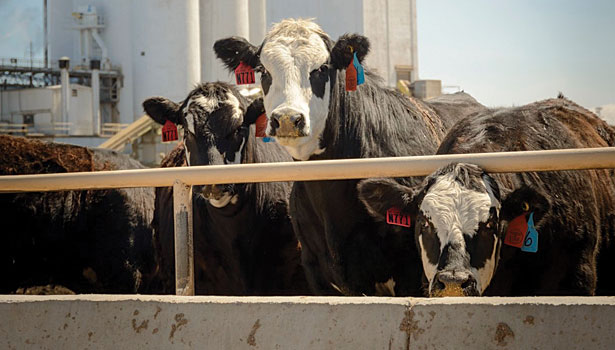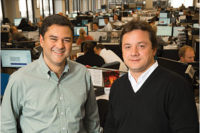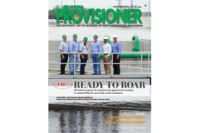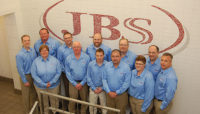 |
| JBS Five Rivers’ Kuner feedlot worked with Temple Grandin to re-design its processing area for incoming cattle, which are quietly steered through a curved walkway in order to ease stress as they are examined and treated before entering the feedlot. |
2013 Processor of the Year
JBS USA: Investing in supply
Q&A with Mike Thoren, president and CEO, JBS Five Rivers.

Mike Thoren: JBS Five Rivers is a cattle-feeding business within JBS. We have 12 feed yards in North America — 11 in the U.S. and one in Canada. Overall, we provide approximately 30 percent of the fed supply for the JBS beef plants. … We’re the biggest live production under the JBS crown. We work with JBS’ beef-processing operations to provide supply, but also differentiated supply — program-type cattle, higher-quality cattle. We really try to work to fit their sales and orders. That said, we are a “for-profit first, for-supply second” type of a company. So, we’re like any other cattle feeder, trying to make money, owning cattle, and JBS isn’t Five Rivers’ sole customer.
Hanacek: On the Five Rivers side, how did the integration of the company into JBS go, and now that the company has been investing in “next steps” kinds of improvements, how has that process evolved? From your perspective, what are some of the more innovative things that have happened on your end?
Thoren: We joined the JBS team in late 2008. It’s been an exciting ride. JBS’s foundation has six values: Planning, Determination, Discipline, Availability, Sincerity and Simplicity. And through that purchase and integration we really saw a company that focused on values. At the time [of our purchase], JBS also had purchased a big beef company, they were in the process of purchasing Pilgrim’s Pride, and building a trucking company. There was a lot of stuff going on that would bring most companies to a standstill, because they would have thought about all the complexities and the “what-ifs”. JBS, however, had a guiding principle to get things integrated, get them done in a simple, reasonable manner and move forward with that. That’s what we’ve seen. There’s a Brazilian saying that translates roughly to, “There is always a way.” And we live by that every day here. If it’s a good idea, we enact it and jump on it instead of thinking about it and agonizing over it for a long time. This is a culture that gets things done.
Hanacek: Can you discuss the relationship between Wesley Batista, president and CEO of JBS S.A.’s global operations, and Five Rivers, and how it has affected capital investment there?
Thoren: Most beef processors, if they have cattle ownership, would see it as a necessary evil — just something to have in order to lock supply up. But Batista is excited about the cattle business. He loves cattle ownership, sees it as a real opportunity and understands it very well. He takes a personal pride in that cattle ownership and investing in the facilities. We just recently spent $18 million completely renovating the feed yard here near Greeley — the Kuner feed lot. It’s a great thing, it’s great for cattle performance, but it also works into the JBS story. It’s close here to the Denver airport, so we can bring in customers from all over the world and take them to the feed yard, take them to the beef-packing plant that’s nine miles away and bring them here to corporate headquarters. I don’t think there’s anybody that can offer that strong of a sales and promotion venue inside a single work day.
Hanacek: What are some of the investments? What are some of the improvements that were made at Kuner?
Thoren: We had a really tough spring here. We probably had 30 inches of snow in the last four weeks [leading up to mid-May], which would be terrible on an old, flat feed yard. With what we’ve done at Kuner, the first thing you notice is how the drainage is set up, so that as snow melts or rain hits, it runs off quickly. So cattle get optimum living conditions, because cattle want to be dry and comfortable. We’ve set these yards up to drain so they dry out more quickly, [by elevating the entire yard] — it’s basically a hill that’s 30 feet higher than the road. Prior to that renovation, that area was the level of the road. … Then, we upgraded all the facilities. We rebuilt the feed mill to the most current and accurate technologies. The basic thing is, the whole lot is geared for animal comfort. We believe that’s the right thing to do; the most humane way to treat the animals. But also, cattle that are comfortable perform the best.
Hanacek: So, those were the primary investments at Kuner. What other investments have happened at Five Rivers since the acquisition?
Thoren: We’ve spent money across our 12 facilities. We’ve done major rebuilds, or completely new rebuilds on four feed mills, which nobody in the industry has done near that much. That’s one-third of our facilities where we’ve put new mills in, significantly new mills in the last two years. I would say that’s one thing that we’re miles ahead of the industry on is feed mills.
Hanacek: What other innovative changes, or other parts of the transition were successful from your perspective?
Thoren: I don’t think we can emphasize enough, the cultural change. That’s the biggest thing — that can-do attitude, that there is a way. This is a volatile, tough business, and a lot of people have failed in it. JBS came in in a big way and is successful because they’re smart, they understand the business, and they don’t get wrapped around the axle with the complexities or subtleties of it. They keep the big picture in mind and what the purpose was, and that’s a big deal. They give us enough support to do our business well, but they give us enough freedom to run our business as well.
Looking for a reprint of this article?
From high-res PDFs to custom plaques, order your copy today!






